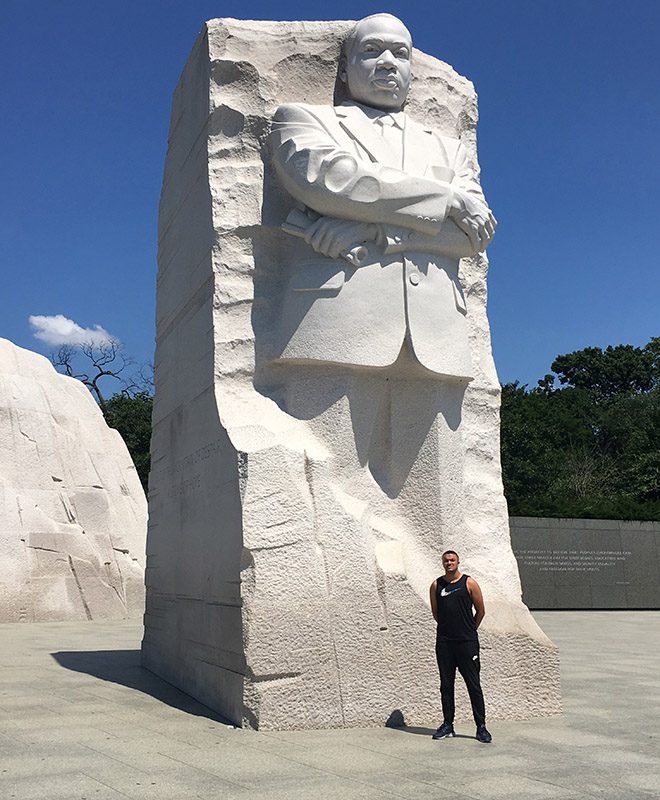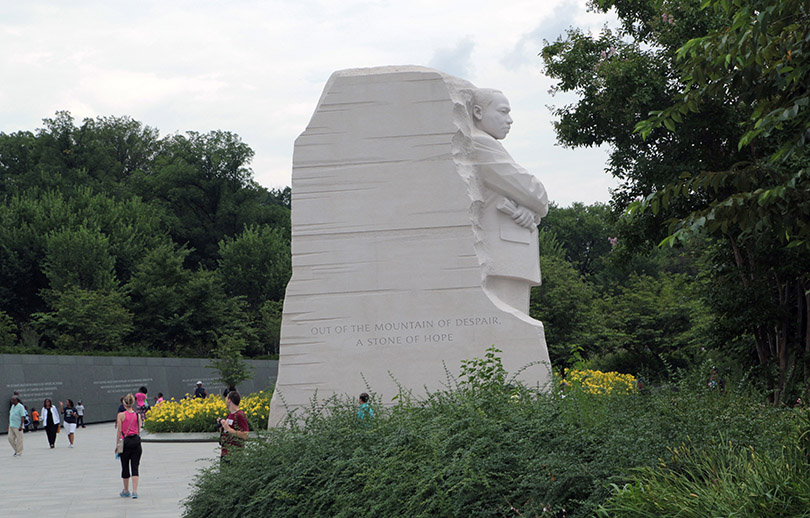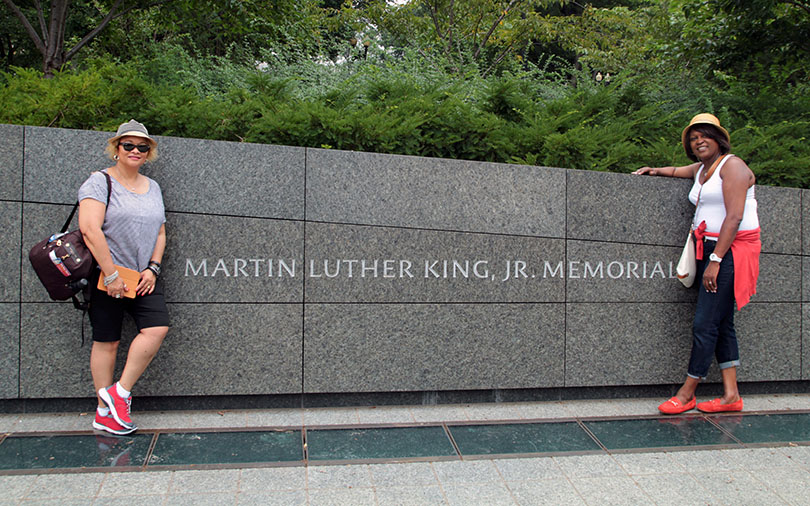
David at the 30-foot high MLK National Memorial, Washington; (c) Soul Of America
MLK National Memorial
28 August 2013 marked the 50th anniversary of Dr. Martin Luther King’s historic “I Have A Dream Speech,” which in many ways was the crowning moment of his relentless pursuit of the American Dream — Freedom, Democracy and Opportunity for all. This monument of stone memorializes his contributions.
At the beginning of the Civil War in 1861, President Lincoln only wanted to preserve the Union. That changed by 1865, shortly before his assassination. President Lincoln mentioned a vision of equality in this country. Dr. Martin Luther King’s speech atop the steps of the Lincoln Memorial expanded upon that vision.
Although Dr. Martin Luther King’s speech is often the focal point of the March On Washington on 28 August 1963, it is important to emphasize the work of hundreds of civil rights activists and private citizens leading to that unprecedented event, including:
A. Phillip Randolph
Bayard Rustin
John Lewis
Andrew Young
James Garner
Cleveland Williams
Whitney Young
Roy Wilkins
Jessie Jackson
Dr. Ralph Bunch
Hosea Williams
Ralph Abernathy
James Baldwin
From the entertainment industry Harry Belafonte, Sidney Poitier, Ruby Dee, Ossie Davis, Marian Anderson, Jackie Robinson, Bill Russell, Josephine Baker, Lena Horne, Diahann Carroll, Marlon Brando, Paul Newman, Sammy Davis Jr., Charlton Heston, Burt Lancaster, Joan Baez, and Bob Dylan were among the contingent of celebrities and pro athletes supporting the Civil Rights Movement via financial contributions and presence at the march.
The bountiful voice of Mahalia Jackson, Dr. King’s favorite singer, set the vibe. All of them made the occasion momentous and told America that legalized segregation and unequal rights must end.
At the end of the day, it was King’s exceptional oratory skills and widely-recognized prose of equality—through non-violence—that captivated the world.
The desire to have Dr. King’s memorial take his rightful place in our nation’s capital with other national leaders of yesteryear began to take shape in 1996. Congress authorized Dr. King’s fraternity, Alpha Phi Alpha, to establish such a memorial. Through the formation of the Martin Luther King, Jr. National Memorial Project Foundation, the location, and design came to fruition sculptor. Though controversial to some, the bold sculpture by Chinese artist Master Lei Yixin has stood the test of time.
Celebrating its Grand Opening on August 28, 2011, The Martin Luther King, Jr. Memorial stands today not only as a commemoration of Dr. King’s life and work but also as a brilliant symbol of the strides our society has made since the Civil Rights Movement era, as well as how we must keep striving, together as a nation, to reach the mountaintop.
Located on Washington DC’s Tidal Basin, the Memorial is fashioned in a crescent geometric pattern within a trilateral configuration that incorporates awe-inspiring views of the Abraham Lincoln and Thomas Jefferson Memorials, other great pillars of history symbolizing the shared desire to forge a nation truly for, of and by the people—all people—regardless of race, creed or color.
Whether visiting during the day or at night, the MLK National Memorial is a commanding presence on the D.C. landscape, encapsulating the ideals of justice, hope, democracy, and love – which appeared over and over in Dr. King’s written and oratorical messages.

Engraved words aside the MLK National Memorial; (c) Soul Of America
Each element of the Memorial sends its own distinctive, yet collectively powerful message. There is “The Mountain of Despair”, symbolizing the place where our nation lived for so many decades and tried valiantly, in many ways, to overcome. On one side is a quote from Dr. King’s 1963 speech: “Out of the mountain of despair a stone of hope.”
The Mountain is parted in two, giving way to The Stone of Hope. Created from a unique white granite with color inclusions reportedly only found in China, the Stone is the focal point of the memorial. Highlighted by King’s contemplative gaze and posture captured in a life-like, 30-foot statue, his image burgeons forth from the Stone, his arms folded authoritatively across his chest characterizing his steadfast resolve to let nothing deter him from attaining the vision of providing future generations with a society comprised of love, tolerance, and equality.
Rounding out the trilateral configuration are the North and South Walls on either side of the spacious plaza, possessing more than a dozen poignant inscriptions of vignettes from Dr. King’s sermons and talks, grand speeches, and written instruments throughout his lifetime.
There was a controversy between the King family, historians, and others over the abbreviated quote from a sermon Dr. King gave in 1968, “I was a drum major for justice, peace and righteousness”, inscribed on one side of the Mountain of Despair. Award-winning poet and consultant on the memorial, Maya Angelou said “The quote makes Dr. King look like an arrogant twit.” Though no solution will satisfy everyone, on 1 August 2013, the quote was removed. In order to preserve the balance and integrity of the Memorial, both sides have been reworked.

Sisters visiting MLK National Memorial; (c) Soul Of America
Nevertheless, the memorial’s creation and prominent placement remain as defining moments to Dr. King’s life, work, and legacy, and to our country’s storied history.
PHONE: National Park Service 202-426-6841
WEBSITE: http://www.nps.gov/mlkm/index.htm
